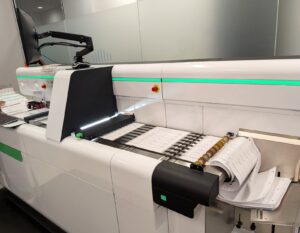In today’s fast-paced industrial and warehousing environments, ensuring safety has become increasingly complex. The intricate choreography of moving machinery, forklifts, conveyors, and employees navigating narrow aisles calls for innovative solutions that can preemptively prevent accidents before they happen. Warehouse collision avoidance systems, protective guard rails, fall protection measures, and barrier fencing revolutionize safety management in these dynamic settings, offering cutting-edge tools to enhance workplace safety and productivity.
This blog will delve into the importance of these advanced safety systems, exploring the technology behind collision detection and the transformative benefits of real-time warnings. We’ll also examine how Bradford Systems’ safety products contribute to a safer, more efficient workplace.
The Need for Collision Avoidance Systems in Dynamic Warehouse Environments
Warehouses are busy environments with multiple activities happening at once. Forklifts move heavy pallets, conveyors transport products, and employees work nearby. While this setup boosts productivity, it also raises the risk of collisions between vehicles, equipment, and people.
Workplace accidents are costly. They lead to direct damages, lost productivity, injury claims, and potential legal issues. Additionally, they harm employee morale and create unsafe working conditions. For companies in high-volume, fast-paced spaces, collision avoidance solutions are essential. These technologies prevent accidents, ensure smoother workflows, and create a safer workplace. In turn, they improve overall efficiency and operational success.
Collision Avoidance Systems: Leveraging Technology for Real-Time Safety
Collision avoidance systems are among the most advanced solutions available for industrial safety. Leveraging real-time technology, these systems use sensors, cameras, and sometimes even artificial intelligence to detect objects and movement patterns and send alerts to operators and employees about potential hazards.
How Collision Detection Works
Most collision avoidance systems work by analyzing the proximity of moving machinery, inventory racks, and personnel. They use several technologies, such as:
- Proximity Sensors: These sensors detect nearby objects and are commonly used on forklifts and other machinery to prevent collisions with vehicles or pedestrians.
- Radio-frequency Identification (RFID): RFID tags, worn by employees or attached to equipment, track the location and movement of personnel and machinery in real-time.
- Camera-Based Solutions: High-definition cameras monitor activity and use image recognition to identify people and objects in a machine’s path.
- Artificial Intelligence (AI): AI-enhanced collision detection identifies patterns and predicts potential accidents, alerting operators before incidents occur.
These technologies work together to improve safety and prevent accidents.
Guard Rails: Physical Barriers with a Strong Protective Impact
While collision avoidance systems leverage technology, traditional safety barriers like guard rails provide a physical line of defense against accidents. Guard rails are particularly effective in high-traffic areas where forklifts and machinery frequently operate. Bradford Systems offers durable guard rail systems with bright yellow coating for high visibility, ensuring they stand out in any warehouse setting.
Key Benefits of Guard Rails in Collision Prevention
Guard rails help create clear walkways for employees, separating pedestrian paths from machinery zones. This minimizes the risk of vehicle-pedestrian collisions by ensuring workers and machines stay in designated areas.
Bradford Systems’ guard rails are impact-resistant, built to absorb force during accidental collisions. This protects personnel, machinery, and infrastructure from severe damage.
Coated in bright colors like yellow, guard rails improve visibility. This visual cue reminds operators to stay within boundaries, especially in areas with limited lighting or heavy traffic.
By physically separating pedestrian paths from machinery zones, guard rails ensure safer workflows and support organized traffic flow in busy warehouse environments.
Barrier Fencing: Creating Controlled Access Zones
Barrier fencing restricts access to high-risk areas, such as zones with automated equipment or hazardous materials, reducing the chance of accidents caused by unauthorized access.
Like guard rails, barrier fencing provides a visual cue, increasing employee awareness. It reminds employees that certain areas are restricted or require extra caution.
Barrier fencing is highly customizable and can be tailored to suit unique floor plans. Bradford Systems offers adjustable options to meet various warehousing needs.
By adding barrier fencing, warehouses can better control foot traffic, reduce accidents, and improve safety.
Bradford Systems: Your Partner in Warehouse Safety
As a leader in warehouse safety solutions, Bradford Systems offers a range of industrial safety equipment and safety supplies designed to meet each facility’s unique demands. Their products include advanced collision avoidance systems, durable guard rails, and customizable barrier fencing, each engineered to promote safety, prevent accidents, and enhance operational efficiency.
Bradford Systems’ team provides expert consultation to help businesses identify the safety measures that best suit their needs. Whether your warehouse has high-traffic forklift zones, elevated workspaces, or automated machinery, Bradford Systems delivers solutions that protect personnel, assets, and infrastructure.
Conclusion
In an era where efficiency and safety are paramount, warehouses cannot overlook the benefits of collision avoidance technology and physical safety barriers. Bradford Systems’ collision detection systems, guard rails, and barrier fencing solutions redefine industry standards by creating a safer, more organized workplace. With these systems in place, businesses minimize accident risks and achieve greater operational efficiency, resulting in a win-win for employees and employers alike.
By combining advanced collision technology with traditional safety barriers, Bradford Systems offers a comprehensive solution to the complex challenges of warehouse safety. The future is bright- and collision-free for warehouses looking to enhance safety and streamline operations.
Why are industrial safety items a must in our day-to-day lives?
Industrial safety items are crucial as they protect workers from accidents, injuries, and even fatalities. By implementing safety equipment like helmets, goggles, gloves, and safety harnesses, workplaces can reduce risks, prevent mishaps, and ensure a secure environment for employees to operate efficiently.






